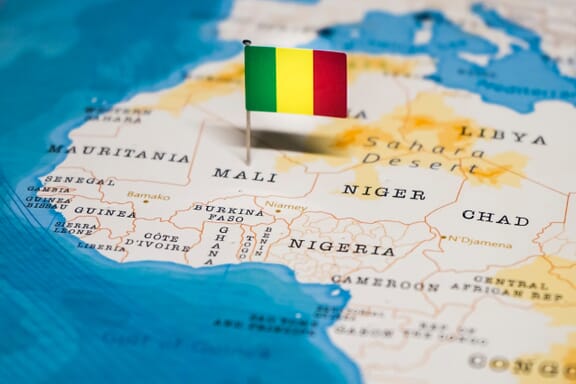Mali is located in the Northern Africa region at latitude 17.570692 and longitude -3.996166 and is part of the African continent.
The DMS coordinates for the center of the country are:
- 17° 34' 14.49'' N
- 3° 59' 46.20'' W
You can see the location of Mali on the world map below:

Mali Neighboring Countries
The neighboring countries of Mali (ML) are:
- Algeria (DZ)
- Burkina Faso (BF)
- Cote d’Ivoire (CI)
- Guinea (GN)
- Mauritania (MR)
- Niger (NE)
- Senegal (SN)
Mali is a landlocked country, which means it does not have direct access to the open ocean.
Mali Related Content
Mali Key Facts
| Country | Mali |
| Coordinates | Latitude: 17.570692 Longitude: -3.996166 |
| Country Codes | Alpha 2: ML Alpha 3: MLI |
| Country Flag Emoji | 🇲🇱 |
| Int. Phone Prefix | +223 |
| Capital city | Bamako |
| Continent Subcontinent | Africa Northern Africa |
| Country Area | 1,240,192 sq km |
| Population 2021 | 20,855,724 World Rank: 59 |
| Median Age | 15.1 |
| Life expectancy | 58.9 |
| Major languages | French (official), Bambara 46.3%, Peuhl/Foulfoulbe 9.4%, Dogon 7.2%, Maraka/Soninke 6.4%, Malinke 5.6%, Sonrhai/Djerma 5.6%, Minianka 4.3%, Tamacheq 3.5%, Senoufo 2.6%, Bobo 2.1%, unspecified 0.7%, other 6.3% (2009 est.) |
| UTC/GMT Time | Number of time zones: 1
|
| Internet TLD | .ml |
| Biggest Airport | Modibo Keita International Airport (BKO) |
| Average temperature | 28.25 °C 82.85 °F |
| Administrative Divisions | 1 district 10 regions |
| Political system | Presidential representative democratic republic |
Mali Economy Facts
| World Bank Income Group | Low income |
| World Bank Region | Sub-Saharan Africa |
| Currency | CFA Franc (XOF) |
| GDP in 2020 | $17.5 (billions of USD) World Rank: 119 |
| GDP per capita in 2020 | $862 World Rank: 173 |
| Major Industries / Economic Sectors | Agriculture, manufacturing, energy, services |
| Top 5 Import Countries | China, France, United States, Senegal, Germany |
| Top 5 Export Countries | China, Ivory Coast, United Arab Emirates, India, Thailand |
Biggest Cities in Mali
Here are the largest cities in Mali based on 2021 data:
| City | Population |
|---|
| Bamako | 2,009,109 | Sikasso | 213,977 | Segou | 133,501 | Mopti | 108,456 | Koutiala | 104,927 | Kayes | 77,207 | Kati | 66,895 | Markala | 53,738 | Gao | 49,483 | Kita | 46,435 |
Map of Mali with the Largest Cities
Other Countries in the Northern Africa Region
- Where is Algeria?
- Where is Benin?
- Where is Burkina Faso?
- Where is Cabo Verde?
- Where is Cameroon?
- Where is Chad?
- Where is Comoros?
- Where is Djibouti?
- Where is Egypt?
- Where is Equatorial Guinea?
- Where is Eritrea?
- Where is Ethiopia?
- Where is Gabon?
- Where is Gambia?
- Where is Ghana?
- Where is Guinea-Bissau?
- Where is Guinea?
- Where is Ivory Coast (Côte d’Ivoire)?
- Where is Liberia?
- Where is Libya?
- Where is Mauritania?
- Where is Morocco?
- Where is Niger?
- Where is Nigeria?
- Where is Sao Tome and Principe?
- Where is Senegal?
- Where is Sierra Leone?
- Where is Somalia?
- Where is Sudan?
- Where is the Central African Republic?
- Where is Togo?
- Where is Tunisia?